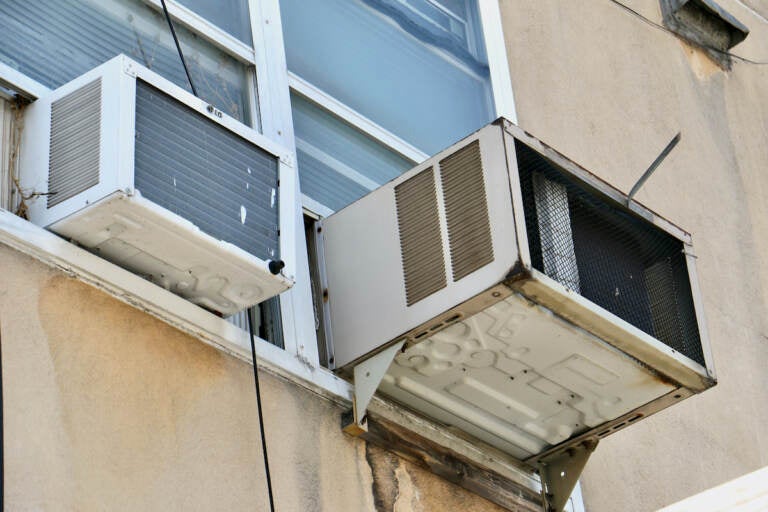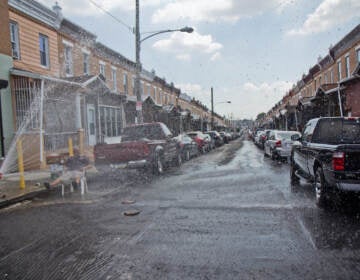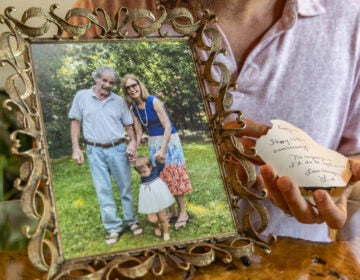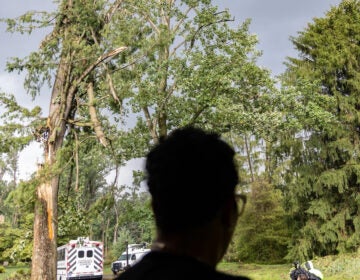Free air conditioners available again in Pa. through utility assistance program
The A/C units and repairs are available only to people who received LIHEAP or weatherization assistance in the past year.
Listen 1:09
Window air conditioners in an building on Race Street. (Emma Lee/WHYY)
Free air conditioners in Pa.: What you need to know
Are you a Pa. resident who received LIHEAP assistance this past heating season or who is currently receiving federally funded weatherization assistance? You could be eligible to receive free air conditioners or repairs.
- State officials recommend calling your local weatherization agency
- Find your local weatherization agency here
Pennsylvania is offering free air conditioning units and repairs again this summer to some residents.
The cooling assistance comes as the Philadelphia region prepares for what’s expected to be a hotter-than-normal summer. Government forecasters predict 2024 could be the world’s warmest year on record.
“The goals of the program are to provide healthy homes for individuals that otherwise could not afford to make those improvements to their home,” said Nic Horting, director of the Center for Residential Reinvestment Programs at the Pennsylvania Department of Community and Economic Development. “Demand is definitely high. The need is there.”
It’s the third summer the state is using federal funding from the Low Income Home Energy Assistance Program, or LIHEAP, to provide cooling help. The program offers eligible Pennsylvania families two Energy Star–rated room air conditioner units, or one unit and a fan, or repair or replacement of an existing but broken central air conditioning system or heat pump.
Pennsylvania’s program does not offer assistance for electricity bills, like some state programs do.
Last year, Pennsylvania’s program provided more than 3,000 window or through-the-wall A/C units, more than 300 fans, more than 500 repairs or replacements of central A/C systems, and 15 repairs or replacements of heat pumps, according to the DCED.
This summer, $5.3 million is allocated for the statewide program, which is funded with money left over from the heating assistance season. Officials say that amount is less than last year and estimate it could serve roughly 2,400 households.
How to sign up
The program is only open to people who received some form of LIHEAP assistance this past November through April or who are currently receiving federally funded weatherization assistance.
This past heating season, LIHEAP was reserved for households earning 150% of the federal poverty line, or $21,870 for an individual and $45,000 for a family of four. The income cutoff for weatherization assistance is 200% of the federal poverty line, or $29,160 for an individual and $60,000 for a family of four.
If you’ve recently received weatherization assistance or a LIHEAP crisis grant from a local weatherization agency, that agency may reach out to you about the summer cooling program.
If you haven’t heard from your local agency yet, or you received a LIHEAP cash grant, the DCED’s Horting recommends calling your local weatherization agency. A list of agencies by the counties they serve is available online.
There is no way to apply directly to the cooling assistance program, Horting said.
In past years, participants have been required to present the letter confirming their recent receipt of LIHEAP or weatherization assistance.
The portion of the program providing window or through-the-wall A/C units and fans closes Aug. 31.
A need for cooling bill assistance
Even when a household has access to an air conditioner, they may not be able to afford to run it.
“If you’re going to burn an air conditioner, it’s going to make your bill go up,” said Victoria Miles-Chambliss, secretary and treasurer of the Kingsessing-based nonprofit Empowered CDC, who helped people try to navigate the cooling program last summer. “It’s like, I either sweat to death or I get air conditioning and don’t have enough money to … get medication or this, that and the other.”
Some states, including Delaware, allow LIHEAP money to be used for summer electricity bills. But so far, Pennsylvania’s LIHEAP cooling pilot program only covers air conditioning units or A/C system repairs.
A survey of over 100 residents of low-income neighborhoods in Philly by the faith-based nonprofit Esperanza and Community Legal Services last year found that just 6% of respondents lacked an air conditioner in their homes. But 76% struggled to afford their energy bills in the summer.
“You can have the air conditioner, but if you can’t afford it, then it’s not going to really help you when it’s really hot,” said Christina Gareis, a former community public health coordinator at Esperanza who co-authored the report.
A whopping 89% of survey respondents said they limit their use of air conditioning to keep costs down.
“Most respondents are limiting A/C use so they don’t get a shutoff notice,” said Ángel Ortiz-Siberón, vice president of research & strategic initiatives at Esperanza. “Yet many of our respondents still dealt with shut off notices during the summer.”
Over the last few years, tens of thousands of PECO customers have had their electricity shut off for nonpayment each summer, excluding 2020, when terminations were paused because of the pandemic.
Nationwide, households of color experience energy insecurity at higher rates than white households. Nearly all of the respondents to Esperanza’s survey identified as either African American or Hispanic/Latinx. Many live in ZIP codes in North and West Philly that were at least partially redlined.
“People should be able to be cool in their own homes, as opposed to having to leave their homes for a cooling center on high heat days,” Dr. Jamile Tellez Lieberman, senior vice president of community engagement, research and health equity at Esperanza, wrote in an email. “Even beyond A/Cs, it’s a question of equity and justice, colored by race.”
Based on input from residents, Community Legal Services and Esperanza recommended Pennsylvania expand LIHEAP bill assistance year-round to cover both heating and cooling by allocating state money to supplement federal funding.
“The number one barrier [to cooling] is that there’s not grant assistance available in the summer to the extent that there is assistance available in the winter,” said Joline Price, a supervising attorney in the energy unit at Community Legal Services. “We would want people to be able to get grants both for heating and cooling, not to be choosing between the two.”
A spokesperson for the Pennsylvania Department of Human Services, which administers LIHEAP bill assistance, said the agency is open to exploring a cooling program in the future.
“We recognize that sweltering summer months can pose a threat to the health of vulnerable Pennsylvanians,” spokesperson Natalie Scott wrote in an email.
But without additional funding, Pennsylvania would need to take money away from the traditional heating bill assistance program to pay for cooling bill assistance, Scott said. DHS has not yet studied the demand and costs associated with running LIHEAP bill assistance year-round but plans to do so in the future.
“We plan to work in partnership with our stakeholders and advocates to analyze the demand and cost of these programs so we can balance these needs and serve the vulnerable citizens of the commonwealth throughout the year,” Scott wrote. “DHS is in support of additional funding or the expansion of LIHEAP to better serve Pennsylvanians during the summer heat.”

Subscribe to PlanPhilly
WHYY is your source for fact-based, in-depth journalism and information. As a nonprofit organization, we rely on financial support from readers like you. Please give today.









